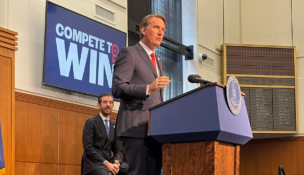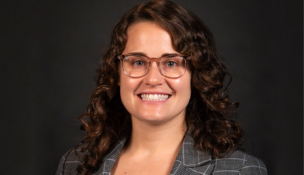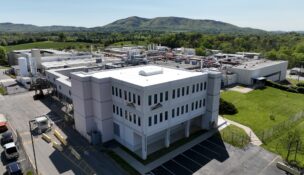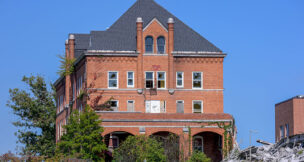Broadband aid
The $2 billion-plus effort to close Virginia’s digital divide

Thanks to fiber optic broadband access, Huckleberry Dairy co-owner Mark Sowers is able to remotely monitor operations on his Floyd County farm. Photo by Don Petersen

Thanks to fiber optic broadband access, Huckleberry Dairy co-owner Mark Sowers is able to remotely monitor operations on his Floyd County farm. Photo by Don Petersen
Broadband aid
The $2 billion-plus effort to close Virginia’s digital divide
A couple of Holstein cows poke their heads through the metal gates of the barn as Mark Sowers fiddles with one of his most important pieces of farm equipment — a smartphone.
Sowers opens an app on his phone that gives him real-time information from the nearly 300 milking cows that roam Huckleberry Dairy, the 700-acre family farm in Floyd County he co-owns with his brother Curtis. The monitoring system, made by Israeli dairy tech company Afimilk, connects wirelessly to sensors strapped to each cow’s leg and relays information such as the number of steps a cow has taken, the animal’s body temperature and other health facts that help Sowers know when a cow might be ready to breed or give birth.
“It’s a Fitbit for cows,” Sowers says.
Sowers uses the phone app to remotely turn on fans and lights in the calving barn or close curtains to provide shade for the animals. A few months ago, while having dinner in a restaurant 30 miles away, Sowers learned about an equipment failure on the farm, checked the machinery with a live video feed on his phone to determine the problem and then ordered the necessary parts — all before dessert.
He graduated with a degree in dairy sciences from Virginia Tech and has used computers on his farm for years. These days, though, information comes faster than ever. “It’s a far cry from dial-up and AOL,” Sowers says. “There’s no going back.”
Fiber-cable access has been an invaluable tool in Sowers’ efforts to modernize Huckleberry Dairy’s operations with the latest technology. Two years ago, Citizens Telephone Cooperative, the local internet service provider, laid fiber optic cable across the green pastures and hills to his dairy. In fact, Floyd County’s population of about 15,600 residents all now have access to high-speed internet from Citizens, a company founded more than a century ago in response to the need for telephones among rural customers in the Blue Ridge Mountains.
Now, rural regions are again racing to catch up with the latest in communications technology: high-speed broadband. Over the last seven years, a firehose of government and private money has been aimed at bringing high-speed internet to places that have never had it, and perhaps never would have, without government intervention. All told, more than $3.3 billion has been made available to finish the job of closing the digital divide in the commonwealth, including $2.2 billion in state and federal funding; $261 million from local governments; and $952 million from internet service providers.
For Virginia’s rural, less-populous regions, high-speed internet is about more than just streaming Disney+ or YouTube videos. Broadband can represent a lifeline for counties that have lost manufacturing industries, jobs and population. In a world of remote work, banking, education and even doctor’s visits, it’s hoped that broadband can help revitalize places that have struggled for decades.
“This gives rural communities a fighting chance. This is like how the Tennessee Valley Authority transformed people’s lives,” says U.S. Sen. Tim Kaine, likening this generation’s rapid broadband expansion efforts to New Deal-era rural electrification projects.
Much of the recent funding for broadband expansion in Virginia came from measures aimed at dealing with the pandemic’s economic fallout. The American Rescue Plan Act (ARPA) provided more than $700 million in federal funding in 2021, with state and local money raising that amount to $750 million. A year later, the Broadband Equity, Access, and Deployment (BEAD) Program, created through the federal Infrastructure Investment and Jobs Act, awarded another $1.48 billion to the state, funding expansion efforts administered by the Department of Housing and Community Development’s Virginia Telecommunication Initiative (VATI).
In late July, the U.S. Department of Commerce’s National Telecommunications and Information Administration (NTIA) approved Virginia’s initial proposal for the BEAD program, which means Virginia can now request access to the $1.48 billion in federal funding. The same week, Gov. Glenn Youngkin announced that VATI had approved $41 million in grants to 20 Virginia localities, which will give access to more than 18,000 homes, businesses and other sites.
“Broadband is not a luxury; it is a necessity for communities to attract businesses and stay competitive, especially in a world that is only becoming increasingly digital,” says Youngkin, a Republican.
Setting a 2028 goal to achieve universal broadband access in Virginia, Youngkin has continued an expansion initiative that began under his predecessor, Democratic Gov. Ralph Northam.
“Virginia has definitely been the leader as far as bringing broadband service to unserved areas through these grant projects,” says Ed McKay, chief operating officer for Shentel Telecommunications, based in Edinburg in the Shenandoah Valley.
Shentel, which provides high-speed fiber optic internet through its Glo Fiber network, received about $61 million in state and federal grants, augmented by $65 million in company investments, McKay says. The company is constructing high-speed networks in Bedford, Campbell, Franklin, Roanoke and Shenandoah counties, having connected fiber so far to about 6,000 of roughly 18,000 unserved households in those localities.
Statewide, the digital divide has narrowed from around 660,000 homes, businesses and community institutions like hospitals and schools lacking high-speed internet access four years ago to about 120,000 such places now.
But those last points of connection often “are the hardest ones to get to,” says Ray LaMura, president of the Broadband Association of Virginia, the lobbying arm of the Virginia Cable Telecommunications Association. “A lot of these folks, they don’t even have water and sewer from the local government. We’re trying to deploy broadband to those folks who are unserved. And we’ve been very, very successful.”
Fiber in Floyd
Russell Janney steers his pickup truck along a gravel road near the Patrick-Floyd county border, past hay bales dotting freshly cut fields. He follows a stream of straw along the roadside, shielding newly planted grass seed where fiber optic lines have been buried below. The Floyd project cost about $50 million, with Citizens investing nearly half that amount and the rest covered by public grants.
“It would still be a major need out here if not for the [government] funding,” says Janney, an engineering manager for the co-op.
Earlier this year, the FCC changed its definition of high-speed internet, increasing benchmarks to a minimum of 100 megabytes per second for download speeds and 20 Mbps for upload speeds. In Floyd, Citizens’ speeds well exceed those standards, delivering 1 gigabit per second download speeds and 500 Mbps upload speeds.
Fast upload speeds are significant for business retention and attraction, says Lydeana Martin, the county’s community and economic development director. “From a business perspective,” she says, “upload speed is a much more important part of the American economy. A person can sell products or teach classes online. That big upload speed is significant.”
Faster internet is already nourishing home-grown businesses in Floyd. Take for example Shane Edgell, a building designer who has performed work for NASA, the Smithsonian Institution, Virginia Tech and even basketball legend Michael Jordan.
He runs his building integrated modeling firm, EdgellBIM, which creates 3D digital models for buildings and interior infrastructure, such as plumbing and electrical systems, out of an office above a restaurant in downtown Floyd.
“The reason I am here is only because Citizens got fiber to the county,” Edgell says. “I work with images so large, with constant uploads and downloads, I would’ve had to move to Roanoke or Blacksburg or have an office there. Now, I can work from home or my Floyd office.”
It’s also hoped that expanded high-speed internet access could stem population declines in rural areas like Southwest Virginia, which lost nearly 10% of its population between 2010 and 2020, mostly through outmigration, according to the U.S. Census Bureau. Floyd and Montgomery (home to Virginia Tech) were the only counties west of Roanoke that saw population increases during the 2010s.
A report earlier this year from the Federal Reserve Bank of Richmond concluded that “hybrid and remote work arrangements might enable moves to more affordable small towns or rural areas that also have access to broadband and have desirable amenities such as lakes or mountains.”
A 2023 survey of 6,000 Cox Communications customers found that 70% of customers under age 30 say they would be more likely to stay in their community if it had high-speed internet.
“Telework is a huge part” of broadband expansion efforts, says Margaret-Hunter Wade, director of public affairs for Cox, which has expansion projects underway in the Roanoke and Hampton Roads areas. “The ability to stay where you are and do the work that you want to be able to do is incredibly important for customers and for the places where they live.”
The pandemic has significantly increased the number of people working remotely, many from rural communities. The Weldon Cooper Center for Public Service at the University of Virginia found that in 2023, more than three-quarters of Virginia’s rural counties outside urban areas had more people moving in than out, the highest percentage since 1975. Much of that growth was attributable to remote work.
“Everyone can do it now,” says Donna Smith, CEO and general manager of Citizens. When it came to high-speed internet, “there used to be haves and have-nots. Now everybody has it.”
Keeping it rural
In 2023, King and Queen County on the Middle Peninsula became the first Virginia county to achieve 100% broadband deployment. One of the state’s least populous counties, with 6,700 residents, King and Queen’s population has been up nearly 2% during the past three years, according to the Census Bureau.
“Anecdotally, we see more people working from home and doing business from here,” says Vivian Seay, the county administrator.
The six-county Middle Peninsula region sees about 33,000 workers commute outside the region daily, traveling to Richmond, Fredericksburg and even Northern Virginia. That’s the highest number of job commuters in the state, according to the Middle Peninsula Planning District. Hoping to increase the number of people who can work remotely from the Middle Peninsula, King and Queen County broke ground on a 7,000-square-foot, county-owned telework center expected to open in December. The broadband-equipped facility, which will provide workspace and meeting rooms for companies and individuals, also will be home to a Sentara Health medical clinic and planning district offices.
Across the Rappahannock River on the Northern Neck, Lancaster County, with a population just over 10,000, expects broadband to be fully deployed countywide by ISP All Points Broadband next year, says Cherie Kiser, chair of the county Broadband Authority. The Northern Neck Planning District Commission received $18.8 million in state and federal grants to bring high-speed internet to 7,200 households in all five counties on the peninsula.
“Businesses are coming in looking at broadband capabilities, not just for their businesses but for their workers,” Kiser says. “We have to be able to attract and keep workers who then will want new schools, more teachers and access to health care. You can’t operate a business these days without broadband.”
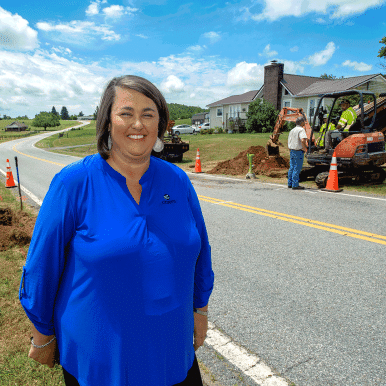
Firefly Fiber Broadband, a Palmyra-based subsidiary of Central Virginia Electric Cooperative, recently announced that it has completed 30,000 broadband connections in Central Virginia as part of its $288 million Regional Internet Service Expansion (RISE) project. The initiative was funded by $79 million in VATI state grants, $32.8 million in local matching funds from the counties and $176.1 million from Firefly and utility partners, including Dominion Energy and Rappahannock Electric Cooperative, according to Firefly spokesperson Melissa Gay.
Firefly and other partners are investing $23.3 million in adjacent counties to reach another 3,606 unserved locations, says Gay, noting the complexity of the projects and funding.
“The funding and construction,” she says, “can be compared to a handmade rural country quilt with sections contributed by various private and public groups.”
Final hurdles
ARPA funds must be spent by the end of 2026 or returned to the federal government. And several hurdles are slowing the race to get fiber to the last locations before that funding deadline.
Thousands of utility poles must be replaced or made ready for fiber hookups. Utility companies such as Dominion and American Electric Power are working with internet service providers to complete that work by 2026.
“We’re in a good spot to have everything done by the 2026 sunset date,” says Matt Heartwell, Dominion’s manager of rural broadband and grid solutions. Dominion is installing 1,100 miles of “middle-mile” fiber through partnerships with local governments and internet service providers in more than 30 counties, with internet companies providing last-mile connections. Those fiber optic cables will also serve to support and modernize the electric grid, which is Dominion’s priority. “Middle-mile fiber serves a dual purpose as it relates to connecting the grid for reliability and new technology, as well as helping ISPs reach unserved areas of the commonwealth,” he says.
Along 216 miles of the Blue Ridge Parkway from the Shenandoah Valley to the Virginia-North Carolina border, providers must wait for permits from the National Park Service to cross beneath the scenic road, a process that takes months and has slowed some broadband work. And in April, rail companies Norfolk Southern and CSX filed federal lawsuits challenging a new state law that accelerates broadband expansion across rail lines. Earlier this year, a federal judge dismissed a similar lawsuit filed by the Association of American Railroads.
One other hurdle to be crossed is ensuring people have basic digital literacy skills to understand how to use high-speed internet to improve their lives.
“It’d be a real shame on the other end of that to find out that people aren’t taking advantage of what we spent all this money for,” says Bryan Byrd, Shentel’s government affairs specialist.
Back in Floyd, Citizens held well-attended education sessions for local broadband customers, says Smith, the cooperative’s CEO. Now, they’re just going to celebrate with a big party on Aug. 3, complete with food trucks and a rock ‘n’ roll band. They’re calling it the “Gig Finale.”
“I love Floyd,” says Edgell, who founded his high-tech design company in his hometown. “It’s a unique, small, mountain town. I love the music, the arts, the community and the seclusion. Being connected without being in a big city is really cool.”
Editor’s note: This story has been updated since publication of the August 2024 issue.
-

